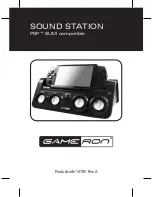
Page 11
Page 10
Page 11
Page 10
Subwoofer Placement Considerations
Unlike regular loudspeakers, subwoofers will often work best when placed in a corner,
even if located a few feet to the side and/or behind the closest main speaker. Typically
the front right and left corners sound the most natural, though rear corner placement
is also an acceptable option. The driver can be facing you or be pointed along either
wall. The low frequency sound waves emitted by subwoofers are quite long and will
therefore interact greatly with the walls of your room. As a result, even small placement
adjustments can have a significant impact on the sound you hear. A room corner will
provide maximum output at a given power level, and the maximum number of room
modes will be excited, translating to a flatter response in most rooms. Often one rather
large peak in the subwoofer’s operational frequency range will standout with corner
placement.
The low frequencies played by your subwoofer tend to be non-directional due the
extraordinarily long wavelengths involved. As a result, regardless of where your
subwoofer is placed, it should not be easily localized, but should instead produce a
balanced and enveloping response.
Factors that can affect performance in relation to placement and localization of the
sound are rattles from shelves, walls, or other nearby objects, as well as distorted
output. If you are having issues with subwoofer localization, try to isolate any rattling
or buzzing objects, or place the sub in another corner of your room. If the sub’s output
is distorted, check to see that you are not at the maximum sub level setting on your
receiver or preamplifier/processor. An overdriven output can induce audible distortion. To
resolve this, you may need to turn down the subwoofer level on your processor and turn
the gain level up on the subwoofer itself to compensate.
One trick (learned from experienced home entertainment installers) is to feed a low
frequency test tone to the subwoofer input while it’s placed in the listening position.
Then walk around the room and identify places where bass is louder (or quieter). This
is easier than moving the subwoofer around. Once you determine a good location - both
audibly and visually - you should be able to make the switch and place the sub in the
new location, with better results.
Finally, you can use the control of the subwoofer’s output level control (gain) and phase
control (0 or 180°) to further blend the sound into the other system speakers as a result
of where you ultimately choose to position the subwoofer. If you are using the subwoofer
in a home theater arrangement, the bass management functions of the preamplifier/
processor will also help to compensate for some of the positioning issues, but remember
that there is no substitute for correct speaker placement. Overall bass level is a
personal preference that varies greatly among listeners. That said, we still suggest you








































